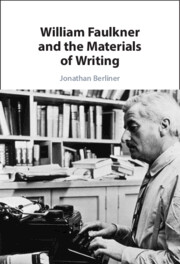Book contents
- William Faulkner and the Materials of Writing
- William Faulkner and the Materials of Writing
- Copyright page
- Contents
- Acknowledgments
- Introduction
- Chapter 1 Not Even Past: Media, History, and Repurposing the Text
- Chapter 2 Parchment Bodies: Race and Writing Materials
- Chapter 3 Inkwell Eyes: Writing, Gender, and the Body
- Chapter 4 Circuits of Media: Airplanes, Newspapers, and the Afterlife of Novels
- Chapter 5 On Carpentry: Religion and the Question of Literature
- Chapter 6 From Ivory to Foolscap: Writing and Intimacy
- Works Cited
- Index
Chapter 1 - Not Even Past: Media, History, and Repurposing the Text
Published online by Cambridge University Press: 24 May 2023
- William Faulkner and the Materials of Writing
- William Faulkner and the Materials of Writing
- Copyright page
- Contents
- Acknowledgments
- Introduction
- Chapter 1 Not Even Past: Media, History, and Repurposing the Text
- Chapter 2 Parchment Bodies: Race and Writing Materials
- Chapter 3 Inkwell Eyes: Writing, Gender, and the Body
- Chapter 4 Circuits of Media: Airplanes, Newspapers, and the Afterlife of Novels
- Chapter 5 On Carpentry: Religion and the Question of Literature
- Chapter 6 From Ivory to Foolscap: Writing and Intimacy
- Works Cited
- Index
Summary
Chapter 1 begins by considering three instances of Faulkner’s writing reused in new contexts: Malcolm Cowley’s 1946 Portable Faulkner; a commonplace book of Faulkner quotations published in 2000; and the current use of the line from his 1951 book Requiem for a Nun, “The past is never dead. It’s not even past,” as a widely circulated shorthand for persistent racial inequities that makes him, for many readers, more relevant today than at the height of his post-Nobel fame in the 1950s. While Faulkner seems to have meant this line as a critique of one character’s view, he likely would not object to the current use of the phrase due to his particular view of history whereby old artistic works take on new life by their use in the present. The chapter examines how Faulkner’s 1936 novel Absalom, Absalom! stages the issue of using documents, here in the form of letters, to construct an historical narrative. While Faulkner is widely understood today as a kind of historian, this chapter shows how he is more concerned with the ways in which historical texts, along with works of the imagination, create a sense of the past as an inherently multimedia endeavor.
- Type
- Chapter
- Information
- William Faulkner and the Materials of Writing , pp. 28 - 52Publisher: Cambridge University PressPrint publication year: 2023

